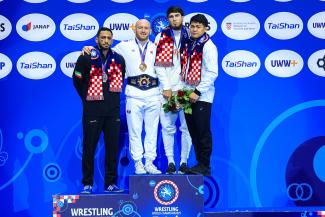Friday's U23 World Championships semifinals set
Friday, October 27, 2023 - 08:58 By Eric Olanowski

TIRANA, Albania (October 27) --- Welcome back to Albania for Day Five of the 2023 U23 World Championships. Today, we’ll pass the baton to the Greco-Roman wrestlers at 60kg, 67kg, 72kg, 82kg and 97kg.
Top Stars in Action:
60kg: Nihad GULUZADE (AZE) – U23 world silver
60kg: Melkamu FETENE (ISR) – U23 world bronze
67kg: Gagik Mishai SNJOYAN (FRA) - U23 world silver
72kg: Diego CHKHIKVADZE (GEO) – U23 world bronze
82kg - Karlo KODRIC (CRO) – U23 world silver
97kg - Alex Gergo SZOKE (HUN) – U23 world gold
97kg - Nitesh NITESH (UWW) – U23 world bronze
Semifinal matches (As they come in):
60kg
Sumit SUMIT (UWW) vs. Anvar ALLAKHIAROV (AIN)
Mert ILBARS (TUR) vs. Romeo BERIDZE (GEO)
67kg
Hasan MAMMADLI (AZE) vs. Sultan ASSETULY (KAZ)
HARUTO YABE (JPN) vs. Mustafa Safa YILDIRIM (TUR)
72kg
Irfan MIRZOIEV (UKR) vs. Michael PORTMANN (SUI)
Shant KHACHATRYAN (ARM) vs. Dmitrii ADAMOV (AIN)
82kg
Aues GONIBOV (AIN) vs. Ruslan ABDIIEV (UKR)
Alperen BERBER (TUR) vs. Emad Ashraf Mohamed ABOUELATTA (EGY)
97kg
Hayk KHLOYAN (ARM) vs. Pavel HLINCHUK (AIN)
Mustafa OLGUN (TUR) vs. Yuri NAKAZATO (JPN)
13:43: I'm still waiting for the system to update to post tonight's semifinal matches. Once everything is updated, I'll put the matches above.
13:23: Yabe upsets U23 world bronze medalist Snjoyan and moves into tonight's 67kg semifinals against Mustafa Safa YILDIRIM (TUR).
13:17: Reigning U23 world bronze medalist Gagik Mishai SNJOYAN (FRA) is in a tight match on Mat C with Japan's HARUTO YABE (JPN). Yabe leads 4-4 on criteria with a minute to go.
13:09: Emad Ashraf Mohamed ABOUELATTA (EGY) just doubled up on four-pointers, punching his ticket to the 82kg semifinals with a 9-0 win over Tyler Adam EISCHENS (USA).
12:55: We're going to start the quarterfinals now on all mats so I'll post the semifinal matches as they come in.
12:35: There's your upset of the day. Lucas LAZOGIANIS (GER) just took out reigning U23 world champion Alex Gergo SZOKE (HUN). Lazogianis was down 3-0 but ended up scoring four points to win 4-4 on criteria.
13:13: You hate to see it against a hometown athlete, but Hasan MAMMADLI (AZE) just made Albania's Ardit ZENELI (ALB) back bend in a way that should be illegal. I'll post the video above.
13:06: It looks like they are going to give Muslim IMADAEV (AIN) the fall over returning U23 world bronze medalist Diego CHKHIKVADZE (GEO). Imadaev was behind 2-1 with :50 left when he went to a four-point head pinch. After a failed challenge that gave the Neutral Athlete the 6-2 advantage, Imadaev stopped a flying squirrel attempt by planting Chkhikvade on his back for the fall.
I'll work on getting up the video of the final slam because it was pretty impressive.
12:54: World medalists Nitesh, Chkhikvadze and Guluzade are all coming up now on Mat A. That's three world medalists coming up in the next four matches.
12:38: We're getting closer on the Szoke watch. He's five matches out on Mat B.
12:23: Tetsuto KANUKA (JPN) just launched Anil ANIL (UWW) twice in 15 seconds to pick up the 11-2 win. The match was tied 2-2 before Kanuka went four, then five on Anil. I'll work on getting the clip up right now so you can see how beautiful the two throws were.
12:12: The noise you hear from the crowd is coming from Mat C, where Dmitrii ADAMOV (AIN) just took out hometown boy Klodjan SHEHU (ALB), 9-0, in the 72kg 1/8 round.
12:08: That match was crazy! It was a rollercoaster of emotions for Abuladze, but he stayed strapped in and picked up the 9-8 victory. At one point of the match, Abuladze went for a pushout and was so successful that he pushed Olsson off the mat and the stage, planting him on his rear end on the floor of the arena.
12:04: The current match on Mat A between Miru Jerry OLSSON (SWE) and Otar ABULADZE (GEO) has been action-packed thus far. Olsson went down 3-0 but gave up eight unanswered points and is currently leading 8-3 with a minute left.
11:45: It's been a slow morning thus far. We're still waiting for a chunk of these stars to have their first matches. We still have at least seven matches before Gagik Mishai SNJOYAN (FRA), Diego CHKHIKVADZE (GEO), Nitesh NITESH (UWW) and Nihad GULUZADE (AZE) come up on Mat A.
But once we get to Snjoyan, the stars will be rolling through match after match.
11:22: After bout 492 wraps up on Mat C, we'll welcome Karlo KODRIC (CRO) to Albania. Last year, Kodric fell to Exauce MUKUBU (NOR) in the finals, becoming the fourth Croatian Greco-Roman wrestler to reach the finals but settle for U23 world silver.
11:15: The biggest storyline we're following today is the return of Alex SZOKE (HUN) after nearly eight months off the mat. Earlier this year, Szoke, the reigning U23 world champion, underwent surgery on his back after the Thor Masters in March.


Share your thoughts.
Comments